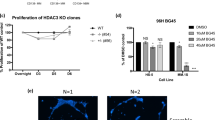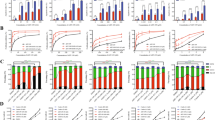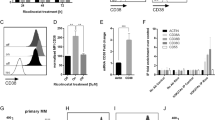Abstract
We have investigated the activity of ITF2357, a novel hydroxamate histone deacetylase inhibitor, on multiple myeloma (MM) and acute myelogenous leukemia (AML) cells in vitro and in vivo. ITF2357 induced apoptosis in 8/9 MM and 6/7 AML cell lines, as well as 4/4 MM and 18/20 AML freshly isolated cases, with a mean IC50 of 0.2 μ M. ITF2357 activated the intrinsic apoptotic pathway, upregulated p21 and downmodulated Bcl-2 and Mcl-1. The drug induced hyperacetylation of histone H3, H4 and tubulin. When studied in more physiological conditions, ITF2357 was still strongly cytotoxic for the interleukin-6 (IL-6)-dependent MM cell line CMA-03, or for AML samples maximally stimulated by co-culture on mesenchymal stromal cells (MSCs), but not for the MSCs themselves. Interestingly, ITF2357 inhibited the production of IL-6, vascular endothelial growth factor (VEGF) and interferon-γ by MSCs by 80–95%. Finally, the drug significantly prolonged survival of severe combined immunodeficient mice inoculated with the AML-PS in vivo passaged cell line already at the 10 mg/kg oral dose. These data demonstrate that ITF2357 has potent anti-neoplastic activity in vitro and in vivo through direct induction of leukemic cell apoptosis. Furthermore, the drug inhibits production of growth and angiogenic factors by bone marrow stromal cells, in particular IL-6 and VEGF.
This is a preview of subscription content, access via your institution
Access options
Subscribe to this journal
Receive 12 print issues and online access
$259.00 per year
only $21.58 per issue
Buy this article
- Purchase on Springer Link
- Instant access to full article PDF
Prices may be subject to local taxes which are calculated during checkout







Similar content being viewed by others
References
de Ruijter AJ, van Gennip AH, Caron HN, Kemp S, van Kuilenburg AB . Histone deacetylases (HDACs): characterization of the classical HDAC family. Biochem J 2003; 370: 737–749.
Arney KL, Fisher AG . Epigenetic aspects of differentiation. J Cell Sci 2004; 117: 4355–4363.
Bolden JE, Peart MJ, Johnstone RW . Anticancer activities of histone deacetylase inhibitors. Nat Rev Drug Dis 2006; 5: 769–784.
Dokmanovic M, Marks PA . Prospects: histone deacetylase inhibitors. J Cell Biochem 2005; 96: 293–304.
Kelly WK, Marks PA . Drug insight: histone deacetylase inhibitors—development of the new targeted anticancer agent suberoylanilide hydroxamic acid. Nat Clin Pract Oncol 2005; 2: 150–157.
Marks PA, Breslow R . Dimethyl sulfoxide to vorinostat: development of this histone deacetylase inhibitor as an anticancer drug. Nat Biotechnol 2007; 25: 84–90.
O’Connor OA, Heaney ML, Schwartz L, Richardson S, Willim R, MacGregor-Cortelli B et al. Clinical experience with intravenous and oral formulations of the novel histone deacetylase inhibitor suberoylanilide hydroxamic acid in patients with advanced hematologic malignancies. J Clin Oncol 2006; 24: 166–173.
Steffen B, Muller-Tidow C, Schwable J, Berdel WE, Serve H . The molecular pathogenesis of acute myeloid leukemia. Crit Rev Oncol Hematol 2005; 56: 195–221.
Minucci S, Pelicci PG . Retinoid receptors in health and disease: co-regulators and the chromatin connection. Semin Cell Dev Biol 1999; 10: 215–225.
George P, Bali P, Annavarapu S, Scuto A, Fiskus W, Guo F et al. Combination of the histone deacetylase inhibitor LBH589 and the hsp90 inhibitor 17-AAG is highly active against human CML-BC cells and AML cells with activating mutation of FLT-3. Blood 2005; 105: 1768–1776.
Insinga A, Monestiroli S, Ronzoni S, Gelmetti V, Marchesi F, Viale A et al. Inhibitors of histone deacetylases induce tumor-selective apoptosis through activation of the death receptor pathway. Nat Med 2005; 11: 71–76.
Nebbioso A, Clarke N, Voltz E, Germain E, Ambrosino C, Bontempo P et al. Tumor-selective action of HDAC inhibitors involves TRAIL induction in acute myeloid leukemia cells. Nat Med 2005; 11: 77–84.
Weisberg E, Catley L, Kujawa J, Atadja P, Remiszewski S, Fuerst P et al. Histone deacetylase inhibitor NVP-LAQ824 has significant activity against myeloid leukemia cells in vitro and in vivo. Leukemia 2004; 18: 1951–1963.
Karagiannis TC, El-Osta A . Will broad-spectrum histone deacetylase inhibitors be superseded by more specific compounds? Leukemia 2007; 21: 61–65.
Sirohi B, Powles R . Multiple myeloma. Lancet 2004; 363: 875–887.
Podar K, Anderson KC . The pathophysiologic role of VEGF in hematologic malignancies: therapeutic implications. Blood 2005; 105: 1383–1395.
Yasui H, Hideshima T, Hamasaki M, Roccaro AM, Shiraishi N, Kumar S et al. SDX-101, the R-enantiomer of etodolac, induces cytotoxicity, overcomes drug resistance and enhances the activity of dexamethasone in multiple myeloma. Blood 2005; 106: 706–712.
Yanamandra N, Colaco NM, Parquet NA, Buzzeo RW, Boulware D, Wright G et al. Tipifarnib and bortezomib are synergistic and overcome cell adhesion-mediated drug resistance in multiple myeloma and acute myeloid leukemia. Clin Cancer Res 2006; 12: 591–599.
Corso A, Ferretti E, Lunghi M, Zappasodi P, Mangiacavalli S, De Amici M et al. Zoledronic acid down-regulates adhesion molecules of bone marrow stromal cells in multiple myeloma: a possible mechanism for its antitumor effect. Cancer 2005; 104: 118–125.
Leoni F, Fossati G, Lewis EC, Lee JK, Porro G, Pagani P et al. The histone deacetylase inhibitor ITF2357 reduces production of pro-inflammatory cytokines in vitro and systemic inflammation in vivo. Mol Med 2005; 11: 1–15.
Armeanu S, Pathil A, Venturelli S, Mascagni P, Weiss TS, Gottlicher M et al. Apoptosis on hepatoma cells but not on primary hepatocytes by histone deacetylase inhibitors valproate and ITF2357. J Hepatol 2005; 42: 210–217.
Pathil A, Armeanu S, Venturelli S, Mascagni P, Weiss TS, Gregor M et al. HDAC inhibitor treatment of hepatoma cells induces both TRAIL-independent apoptosis and restoration of sensitivity to TRAIL. Hepatology 2006; 43: 425–434.
Leoni F, Zaliani A, Bertolini G, Porro G, Pagani P, Pozzi P et al. The antitumor histone deacetylase inhibitor suberoylanilide hydroxamic acid exhibits antiinflammatory properties via suppression of cytokines. Proc Natl Acad Sci USA 2002; 99: 2995–3000.
Carta S, Tassi S, Semino C, Fossati G, Mascagni P, Dinarello CA et al. Histone deacetylase inhibitors prevent exocytosis of interleukin-1beta-containing secretory lysosomes: role of microtubules. Blood 2006; 108: 1618–1626.
Verdelli D, Mattioli M, Fabris S, Nobili L, Intini D, Guerneri S et al. Molecular and biological characterization of three novel interleukin-6-dependent human myeloma cell lines. Haematologica 2005; 90: 1541–1548.
Pittenger MF, Mackay AM, Beck SC, Jaiswal RK, Douglas R, Mosca JD et al. Multilineage potential of adult human mesenchymal stem cells. Science 1999; 284: 143–147.
Golay J, Manganini M, Rambaldi A, Introna M . Effect of alemtuzumab on neoplastic B cells. Haematologica 2004; 89: 1476–1483.
Giavazzi R, Di Berardino C, Garofalo A, Motta T, Gobbi A, Scanziani E et al. Establishment of human acute myelogenous leukemia lines secreting interleukin-1 beta in SCID mice. Int J Cancer 1995; 61: 280–285.
Golay J, Di Gaetano N, Amico D, Cittera E, Barbui AM, Giavazzi R et al. Gemtuzumab ozogamicin (Mylotarg) has therapeutic activity against CD33 acute lymphoblastic leukaemias in vitro and in vivo. Br J Haematol 2005; 128: 310–317.
Guo F, Sigua C, Tao J, Bali P, George P, Li Y et al. Cotreatment with histone deacetylase inhibitor LAQ824 enhances Apo-2L/tumor necrosis factor-related apoptosis inducing ligand-induced death inducing signaling complex activity and apoptosis of human acute leukemia cells. Cancer Res 2004; 64: 2580–2589.
Maiso P, Carvajal-Vergara X, Ocio EM, Lopez-Perez R, Mateo G, Gutierrez N et al. The histone deacetylase inhibitor LBH589 is a potent antimyeloma agent that overcomes drug resistance. Cancer Res 2006; 66: 5781–5789.
Rosato RR, Grant S . Histone deacetylase inhibitors: insights into mechanisms of lethality. Expert Opin Ther Targets 2005; 9: 809–924.
Gui CY, Ngo L, Xu WS, Richon VM, Marks PA . Histone deacetylase (HDAC) inhibitor activation of p21WAF1 involves changes in promoter-associated proteins, including HDAC1. Proc Natl Acad Sci USA 2004; 101: 1241–1246.
Bali P, Pranpat M, Bradner J, Balasis M, Fiskus W, Guo F et al. Inhibition of histone deacetylase 6 acetylates and disrupts the chaperone function of heat shock protein 90: a novel basis for antileukemia activity of histone deacetylase inhibitors. J Biol Chem 2005; 280: 26729–26734.
Khan SB, Maududi T, Barton K, Ayers J, Alkan S . Analysis of histone deacetylase inhibitor, depsipeptide (FR901228), effect on multiple myeloma. Br J Haematol 2004; 125: 156–161.
Rosato RR, Almenara JA, Dai Y, Grant S . Simultaneous activation of the intrinsic and extrinsic pathways by histone deacetylase (HDAC) inhibitors and tumor necrosis factor-related apoptosis-inducing ligand (TRAIL) synergistically induces mitochondrial damage and apoptosis in human leukemia cells. Mol Cancer Ther 2003; 2: 1273–1284.
Lindemann RK, Newbold A, Whitecross KF, Cluse LA, Frew AJ, Ellis L et al. Analysis of the apoptotic and therapeutic activities of histone deacetylase inhibitors by using a mouse model of B cell lymphoma. Proc Natl Acad Sci USA 2007; 104: 8071–8076.
Shi X, Hong T, Walter KL, Ewalt M, Michishita E, Hung T et al. ING2 PHD domain links histone H3 lysine 4 methylation to active gene repression. Nature 2006; 442: 96–99.
Glaser KB, Li J, Pease LJ, Staver MJ, Marcotte PA, Guo J et al. Differential protein acetylation induced by novel histone deacetylase inhibitors. Biochem Biophys Res Commun 2004; 325: 683–690.
Catley L, Weisberg E, Kiziltepe T, Tai YT, Hideshima T, Neri P et al. Aggresome induction by proteasome inhibitor bortezomib and alpha-tubulin hyperacetylation by tubulin deacetylase (TDAC) inhibitor LBH589 are synergistic in myeloma cells. Blood 2006; 108: 3441–3449.
Hideshima T, Bradner JE, Wong J, Chauhan D, Richardson P, Schreiber SL et al. Small-molecule inhibition of proteasome and aggresome function induces synergistic antitumor activity in multiple myeloma. Proc Natl Acad Sci USA 2005; 102: 8567–8572.
Trudel S, Li ZH, Wei E, Wiesmann M, Chang H, Chen C et al. CHIR-258, a novel, multitargeted tyrosine kinase inhibitor for the potential treatment of t(4;14) multiple myeloma. Blood 2005; 105: 2941–2948.
Catley L, Weisberg E, Tai YT, Atadja P, Remiszewski S, Hideshima T et al. NVP-LAQ824 is a potent novel histone deacetylase inhibitor with significant activity against multiple myeloma. Blood 2003; 102: 2615–2622.
Bisping G, Kropff M, Wenning D, Dreyer B, Bessonov S, Hilberg F et al. Targeting receptor kinases by a novel indolinone derivative in multiple myeloma: abrogation of stroma-derived interleukin-6 secretion and induction of apoptosis in cytogenetically defined subgroups. Blood 2006; 107: 2079–2089.
Aggarwal S, Pittenger MF . Human mesenchymal stem cells modulate allogeneic immune cell responses. Blood 2005; 105: 1815–1822.
Chan JL, Tang KC, Patel AP, Bonilla LM, Pierobon N, Ponzio NM et al. Antigen presenting property of mesenchymal stem cells occurs during a narrow window at low levels of interferon-{gamma}. Blood 2006; 107: 4817–4824.
Yasui H, Hideshima T, Richardson PG, Anderson KC . Novel therapeutic strategies targeting growth factor signalling cascades in multiple myeloma. Br J Haematol 2006; 132: 385–397.
Einsiedel HG, Kawan L, Eckert C, Witt O, Fichtner I, Henze G et al. Histone deacetylase inhibitors have antitumor activity in two NOD/SCID mouse models of B-cell precursor childhood acute lymphoblastic leukemia. Leukemia 2006; 20: 1435–1436.
Acknowledgements
We thank Dr T Otsuki (Kavasaki Medical School, Okajama, Japan) for his kind gift of the KMS11, KMS12, KMS18 and KMS20 lines, Dr A Carobbio for the statistical analyses, Dr E Galbiati and G Mascheroni for their technical contribution. This work was in part supported by the ‘Associazione italiana contro le Leucemie - Linfomi (AiL) – sezione.
Author information
Authors and Affiliations
Corresponding author
Additional information
Supplementary Information accompanies the paper on the Leukemia website (http://www.nature.com/leu)
Rights and permissions
About this article
Cite this article
Golay, J., Cuppini, L., Leoni, F. et al. The histone deacetylase inhibitor ITF2357 has anti-leukemic activity in vitro and in vivo and inhibits IL-6 and VEGF production by stromal cells. Leukemia 21, 1892–1900 (2007). https://doi.org/10.1038/sj.leu.2404860
Received:
Revised:
Accepted:
Published:
Issue Date:
DOI: https://doi.org/10.1038/sj.leu.2404860
Keywords
This article is cited by
-
Spatial and temporal dynamics of HDACs class IIa following mild traumatic brain injury in adult rats
Molecular Psychiatry (2022)
-
Emerging agents and regimens for polycythemia vera and essential thrombocythemia
Biomarker Research (2021)
-
Novel Pathophysiological Mechanisms of Thrombosis in Myeloproliferative Neoplasms
Current Hematologic Malignancy Reports (2021)
-
Histone deacetylase inhibitor ITF2357 (givinostat) reverts transformed phenotype and counteracts stemness in in vitro and in vivo models of human glioblastoma
Journal of Cancer Research and Clinical Oncology (2019)
-
Control of cytokine mRNA degradation by the histone deacetylase inhibitor ITF2357 in rheumatoid arthritis fibroblast-like synoviocytes: beyond transcriptional regulation
Arthritis Research & Therapy (2018)



